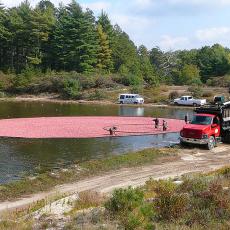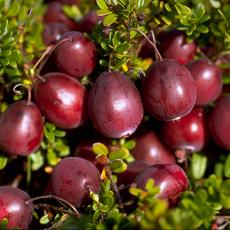With this year’s final crop totals still being tallied, Massachusetts cranberry growers estimate they have harvested around two million barrels of fruit. That harvest is a pleasant surprise for growers who were concerned that the mild winter, early start to the growing season, and late frosts would reduce this year’s harvest. The largest Massachusetts harvest was in 2008 when 2.37 million barrels were harvested. One barrel equals 100 pounds and is the standard measurement for cranberries, used since the days when cranberries were transported in wooden barrels. With approximately 44,000 to 54,000 cranberries in a 100 lb. barrel, this year’s Massachusetts harvest equals 88 to 108 billion individual cranberries.
Growers used various methods to deal with this year’s challenges, including sprinkler irrigation systems to avoid damage from the late frosts. This year’s early season caused the plants to bloom and fruit to ripen earlier than usual. The longer growing season meant there were some issues with fruit quality, including over-ripe fruit and fungal growth. While the Massachusetts cranberry harvest season generally lasts from mid-September to mid-November, growers monitored their crops and some harvested their fruit early to preserve fruit quality.
The UMass Cranberry Station in East Wareham assists Massachusetts cranberry growers in meeting the challenges of variable weather and growing conditions. The Station conducts production-oriented research geared toward improving fruit quality, pest management, water management, and environmental practices. Carolyn DeMoranville, Station Director and Plant Nutrient Management Specialist, said, “There is a lot of science involved in cranberry growing. Massachusetts cranberry growers have used technology and knowledge from the Station to improve their crops and become more sustainable. We have helped introduce new high yield cultivars developed by our colleagues in New Jersey and Wisconsin and contributed to the sustainability of the cranberry growing industry by advising on managing pests and water usage. We work with growers one-on-one, as well as through in-the-field workshops and our annual day-long educational workshop in January. Along with sharing knowledge gained from our research, the Station’s workshops encourage peer-to-peer sharing of information. Much of the Station’s research is done on growers’ farms, including a current study on drainage systems.”
Massachusetts produces 27% of the U.S. cranberry crop, making it the second highest cranberry-producing state after Wisconsin. About 5% of Massachusetts cranberries are sold as fresh fruit and the rest are used in products such as nutrient powder, sweetened dry cranberries, and juice. Thirty percent of the U.S. cranberry crop is sold to international markets, with Europe as a major export destination and growing markets in Mexico, Australia, and Japan. This year, all of the Massachusetts Ocean Spray growers’ crops were designated for export. Ocean Spray, a growers’ cooperative with members throughout the U.S. and Canada, has its corporate headquarters and a sweetened dried cranberry manufacturing plant in Massachusetts. 65% of Massachusetts cranberry growers are members of Ocean Spray.
The Cape Cod Cranberry Growers’ Association provides technical assistance to growers and promotes the cranberry industry. Association Executive Director Jeff LaFleur, said “The growth in the export market for cranberries in the past ten years has meant a change in production practices for Massachusetts cranberry growers. Other countries have very strict requirements for production practices and documentation of practices that promote sustainability, including insect control, water use, and how employees are treated. Massachusetts growers are meeting those standards and helping meet the increased demand for cranberries for use in a wide range of products. In both the United States and the European Union, you can find cranberries in products in almost every grocery store aisle.”
For more information, visit the UMass Cranberry Station website.




